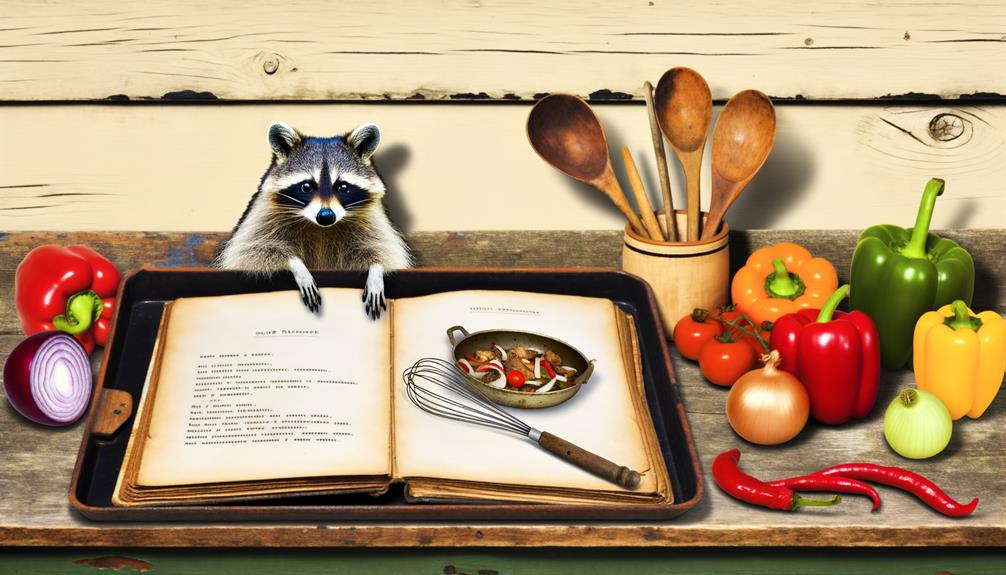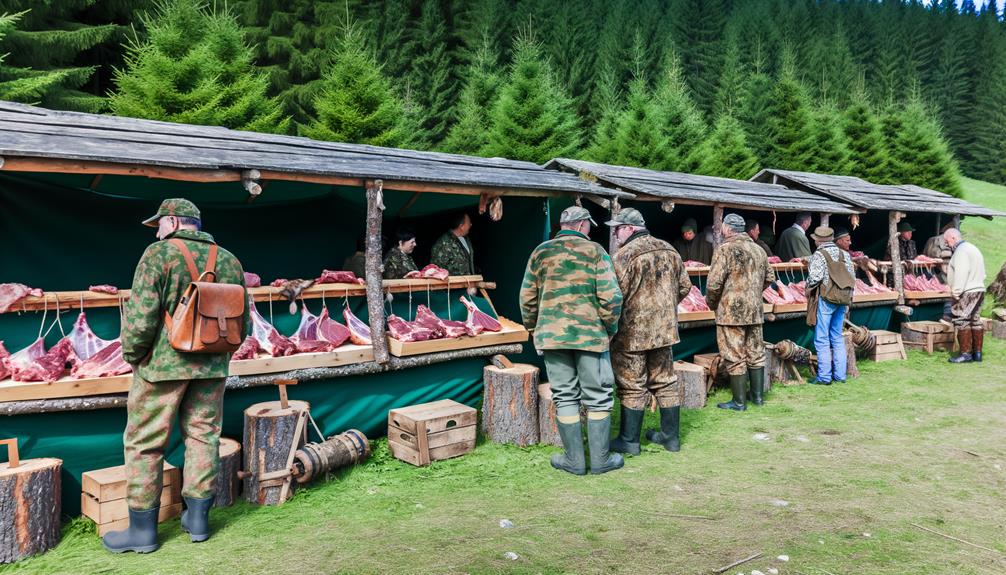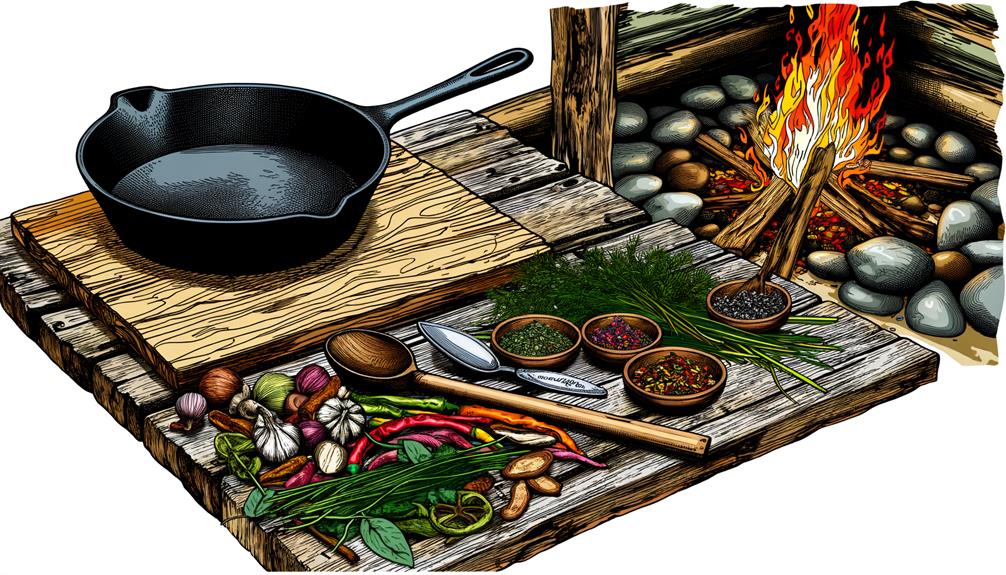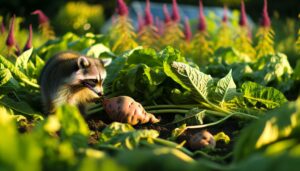How You Can Eat Raccoon: A Guide to Preparation
Raccoon meat is edible and can be a high-protein food source when properly prepared. It is legal in some states, but hunting and trapping must comply with local regulations.
Raccoon meat is rich in protein, vitamins, and essential minerals. Precautionary measures are necessary due to the potential risk of diseases and parasites.
Cooking the meat thoroughly is essential to ensuring safety. Techniques such as braising, roasting, and smoking are commonly used for preparation.
Raccoon consumption varies culturally, with some regions considering it a delicacy. For in-depth insights on legal, nutritional, and health aspects, further details are available.

Key Takeaways
- Yes, raccoon meat can be consumed if properly prepared and cooked thoroughly to avoid health risks.
- It is legal to eat raccoon meat in some states, though regulations vary, requiring adherence to local laws.
- Raccoon meat is high in protein and essential vitamins but must be sourced ethically and legally.
- Proper handling and cooking of raccoon meat are crucial to prevent diseases and ensure safety.
- Cultural acceptance of raccoon meat varies, with some regions considering it a delicacy.
Legal Considerations

Before considering raccoon as a potential food source, it is important to understand the legal regulations that govern the hunting, trapping, and consumption of this animal. Regulations vary significantly by region and are often managed by state or local wildlife agencies. Permits may be required for hunting or trapping raccoons, and specific seasons or quotas might be enforced to maintain sustainable population levels.
Additionally, some jurisdictions impose restrictions on the methods used to capture raccoons to promote humane practices. It is vital to consult local wildlife authorities or legal resources to ensure compliance with all relevant laws. Violating these regulations can result in legal penalties, including fines or other sanctions, and can negatively impact wildlife conservation efforts.
Nutritional Value
Raccoon meat offers a substantial amount of protein and fat, making it a potentially valuable source of macronutrients. Additionally, it contains various vitamins and minerals essential for human health, such as iron, vitamin B12, and zinc.
Evaluating the nutritional composition of raccoon meat can provide insights into its viability as a dietary option.
Protein and Fat Content
Although often overlooked as a food source, raccoon meat offers a notable nutritional profile, particularly in its protein and fat content. Raccoon meat is rich in protein, providing approximately 20 grams per 100 grams of meat, making it a substantial source for those seeking to meet their daily protein requirements.
The fat content in raccoon meat is relatively high, averaging around 15 grams per 100 grams, with a significant proportion of this being unsaturated fats. This composition can be advantageous for sustaining energy levels, though it necessitates mindful consumption to avoid excessive caloric intake.
Given its protein and fat balance, raccoon meat can be a viable option for those in need of alternative nutritional sources, especially in survival situations.
Vitamins and Minerals
In addition to its macronutrient content, raccoon meat is a source of essential vitamins and minerals that contribute to overall nutritional value. Importantly, it contains significant amounts of B vitamins, including B12 and niacin, which are essential for energy metabolism and neurological function.
Furthermore, raccoon meat provides a moderate amount of iron, vital for oxygen transport in the blood, and zinc, significant for immune function and wound healing. Trace minerals such as selenium are also present, offering antioxidant benefits.
The presence of phosphorus supports bone health, while small amounts of potassium aid in cardiovascular function. Collectively, these micronutrients enhance the complete nutritional profile of raccoon meat, making it a viable option for diversified dietary intake.
Sourcing Raccoon Meat

Sourcing raccoon meat primarily involves locating raccoons in their natural habitats, which are typically wooded areas, farmlands, and suburban regions.
Legal hunting guidelines vary by region and must be strictly adhered to, including seasonal restrictions and licensing requirements. Understanding these regulations is essential for both ethical and safe procurement of raccoon meat.
Where to Find Raccoons
Raccoons can be primarily found in various habitats ranging from urban areas to dense forests, making them relatively accessible for sourcing meat. These omnivorous creatures adapt well to different environments, providing opportunities for sourcing in both rural and metropolitan settings. Raccoons are often located near water sources, such as rivers and lakes, due to their dietary needs. Additionally, they are prevalent in suburban areas, frequently scavenging in human settlements.
| Habitat Type | Characteristics |
|---|---|
| Urban | High adaptability, often found near garbage bins |
| Suburban | Common in backyards, gardens, and parks |
| Rural | Located near farms, woodlands, and fields |
| Forested | Dense populations near water bodies and tree-covered areas |
Understanding these habitats is essential for effective and ethical sourcing.
Legal Hunting Guidelines
Regulations pertaining to the hunting of raccoons vary greatly between jurisdictions, necessitating thorough research to guarantee compliance with local laws. Hunters must verify the specifics of:
- Seasonal Restrictions: Many regions impose specific hunting seasons to maintain sustainable raccoon populations.
- Permits and Licensing: Obtaining the appropriate permits or licenses is often mandatory, ensuring that hunters adhere to legal practices.
- Allowed Methods: Certain methods of hunting, such as the use of traps or firearms, may be regulated to promote ethical hunting practices.
These guidelines are designed to balance wildlife conservation efforts with the interests of hunters. Failure to comply can result in legal repercussions, including fines and hunting bans. Hunters are encouraged to consult local wildlife agencies for the most current regulations.
Preparing the Meat
Proper preparation of raccoon meat involves several key steps to guarantee safety and enhance its flavor. Initially, verify the raccoon is free from diseases by examining the internal organs for abnormalities. Next, skin the animal carefully, making sure the removal of the scent glands located near the tail and under the forelegs, as these glands can impart an unpleasant taste.
| Step | Description |
|---|---|
| Examination | Check for diseases by examining internal organs. |
| Skinning | Skin the raccoon, avoiding damage to the meat. |
| Scent Gland Elimination | Remove scent glands near the tail and forelegs. |
| Cleansing | Thoroughly wash the meat to remove any contaminants. |
| Cutting | Cut the meat into manageable portions for further use. |
Thorough washing and proper cutting into portions facilitate uniform cooking and improve taste.
Cooking Methods

While there are various methods to cook raccoon meat, each technique aims to enhance its flavor and make sure it is safe for consumption. Traditionally, raccoon meat is often slow-cooked due to its tough texture, requiring methods that tenderize the meat effectively.
- Braising: This method involves cooking the meat slowly in a pot with a small amount of liquid, allowing the meat to become tender and flavorful.
- Roasting: Raccoon meat can be roasted in an oven, often seasoned with herbs and spices to mask any gamey flavors and to achieve a crispy exterior.
- Smoking: Smoking the meat at low temperatures over several hours can impart a rich, smoky flavor, while also ensuring the meat is fully cooked.
Each technique caters to different culinary preferences, providing versatility in preparation.
Health Risks
Consuming raccoon meat poses several health risks that must be carefully considered and mitigated. Raccoons can carry various zoonotic pathogens, including parasites like Baylisascaris procyonis (raccoon roundworm), bacteria like Leptospira, and viruses such as rabies. These pathogens can cause severe illnesses in humans.
Proper handling and thorough cooking are important to eliminate these risks. Additionally, raccoons often inhabit areas with chemical contaminants, which could bioaccumulate in their tissues. As a result, selecting raccoons from less polluted environments is advisable.
Thorough sanitation practices during butchering and cooking, such as using gloves and ensuring meat reaches an internal temperature of 160°F (71°C), can greatly reduce the likelihood of disease transmission. Hence, informed and cautious preparation is essential for safe consumption.
Conclusion
In an era where culinary exploration knows no bounds, one might be tempted by the unconventional choice of raccoon meat. Ironically, this pursuit, laden with legal, nutritional, and preparatory intricacies, offers a gastronomic adventure few dare to undertake.
While the meat is undeniably nutrient-rich, the potential health risks and meticulous preparation requirements render it an option best left to the truly intrepid. Consequently, raccoon meat remains an enigma in the world of exotic cuisine.






